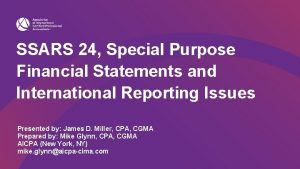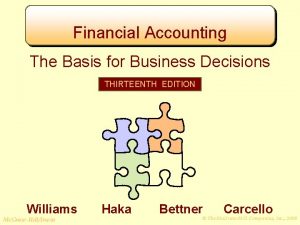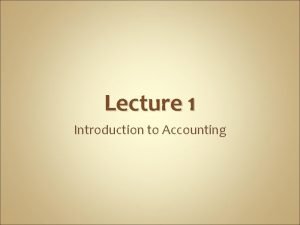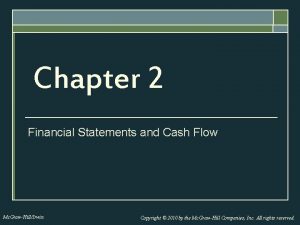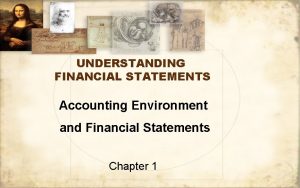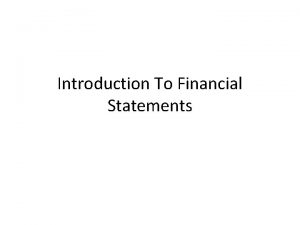Accounting Purpose and Use Financial Statements Matching and










- Slides: 10

Accounting: Purpose and Use Financial Statements, Matching, and Estimation

Our Class Thesis: The purpose of accounting • Profit measurement (to estimate firm performance) • Profit used as a basis for decision making • How to use internal resources to make sales (i. e. manage) • Whether to fund a firm (i. e. investors – external decisions) • Both decisions try to increase firm value LR profit stream • Within an ethical and sustainable context (including CSR) Main concepts: Accrual (matching) cf. cash flow & cost behavior (Contribution Margin Income statement)

Accrual Financial Statements: Cash? PQ (VQ) CM (F) Profit

Accrual statements: MATCHING • Accrual statements tell the story of the firm (business model) • (IS): Revenue model (idea for sales), but at what cost? • (BS): What assets and operations are necessary? • (BS): How are they financed? • (SCF): s there sufficient cash to operate? Is it sustainable? • Matching (alignment of revenue with its cost) is on the INCOME STATEMENT (a. k. a. Profit & Loss or P&L) • BALANCE SHEET balances due to financing of assets • Assets are used to make sales NOT MATCHING • STATEMENT OF CASH FLOWS is to monitor sources & uses

Accounting Conceptual Framework (FASB) • Starts with why: our thesis – provide information to decision makers • Desired characteristics of this information: • Relevant – predictive, confirmatory, timely • Reliable – complete, neutral, reproducible • Consistent – from period to period • Comparable – from firm to firm • Elements: assets, liabilities, equities, revenues, expenses, gains, losses, investment by owners, distributions to owners, comprehensive income

Assumptions and Constraints: • Assumptions: • • Going Concern – stays in business Periodicity – regular end of period Constant Monetary Unit – inflation can be ignored Economic Entity – the boundaries of the company are discernable • Constraints: • Materiality – would it matter to a reasonable investor? Choice of method • Conservatism – low estimates of revenue/gains, high estimates of costs/losses • Cost-Benefit Tradeoff – if the method is not worth the information, don’t • Industry Practices – if other similar firms do it one way, be comparable

Conceptual Framework (FASB) continued • Principles: • Revenue Recognition – at the time of the sales (not when collected) TRIGGERS • Expense Matching – alignment of specific sales with their costs for profit measurement • Historical Cost of assets for depreciation (i. e. matching) • Full Disclosure – of all relevant information (e. g. notes to the financials)

Estimations • Matching helps measure performance • Revenue recognition triggers it (at the time of sale) • Cost measurement issues (cost benefit tradeoff, accuracy? ) • Judgement • Method (e. g. depreciation) • Inputs (accuracy? ) • Manipulation • Performance pay or appearance • Cost of capital (investments) • Cash helps “check” accrual (in addition to being necessary to operate) • Profits should turn into cash at a regular rate (operating CF) • Cash has other sources and uses (investment, financing CFs)

Comparative Balance Sheet –across P&L time Balance Sheet accounts are Permanent accounts that carry over their balances from year to year. Income Statement accounts are Temporary accounts that are closed out to Retained Earnings on the Balance Sheet at the end of each fiscal year. The new year starts with zero balances in each account.

Accrual Financial Statements: Cash? PQ (VQ) CM (F) Profit
 Unit 13 accounting and financial statements
Unit 13 accounting and financial statements Purpose of financial report
Purpose of financial report Special purpose financial statements
Special purpose financial statements Financial accounting and accounting standards chapter 1
Financial accounting and accounting standards chapter 1 Social and environmental accounting ppt
Social and environmental accounting ppt Define matching principle
Define matching principle Basic accounting terms
Basic accounting terms Financial statements and ratio analysis chapter 3
Financial statements and ratio analysis chapter 3 Cash flow to creditors is equal to
Cash flow to creditors is equal to Financial statements and ratio analysis chapter 3
Financial statements and ratio analysis chapter 3 Flow chapter 2
Flow chapter 2


